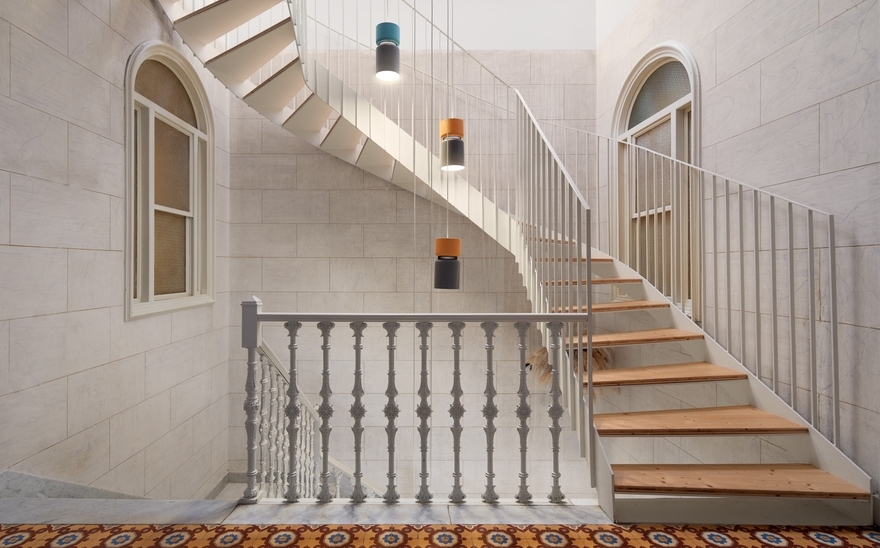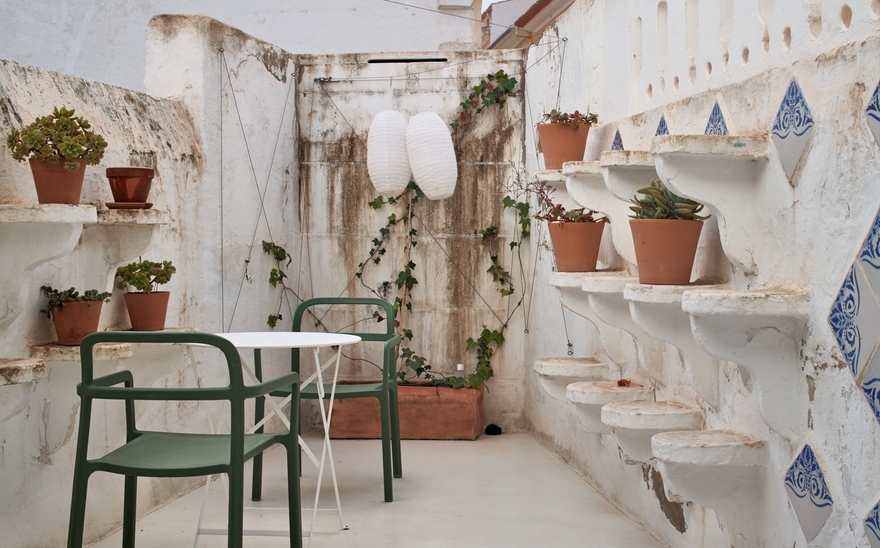How an 18th-Century Menorca Home Became a Stunning Boutique Hotel

In the middle of the Mediterranean port city of Mahón, Menorca’s capital, a new hotel shines a light on the Spanish island’s rich past.
Emma Martí Arquitectura has put the finishing touches on the Hevresac Hotel, a former 18th-century rowhouse that’s now an eight-room boutique hotel.
Martí, who is the principal of her eponymous firm, quickly transformed the space for her childhood friends, building owners Ignasi Truyol and Stephanie Mahé. The project wasn’t without challenges, though. The property had plenty of soul and historic charm but was also tucked between shared walls in a trapezoidal, almost triangular plot that caused some rooms in the five-story home to have oddly shaped layouts. Plus, it didn’t offer much natural light.

Martí aimed to achieve two goals with the project. First, to conserve the building’s original finishes, including mosaic tile, parquet wood floors, stucco walls, and original paintings on wooden beams. Second, to fill the building with “light and life.”
“My intention was for the new materials introduced to coexist with the original ones, providing a new language, lightness, and contemporaneity,” Martí said.
Conservation and Restoration
Martí maintained the building’s facade and also preserved the original rooms inside the home for the hotel conversion. She devised a double wooden skin for the doors leading to each room to preserve the original woodwork. She carefully designed the wooden skin to maintain the doors’ original aesthetics while providing privacy and comfort. Martí also kept the original mosaic floor tiles and parquet, but where original elements had to be replaced, she used new fixtures including micro-cement for flooring, but always with a variant of the original material.
For the exterior windows, Martí used solid, treatment-preserved Flanders pine, and for the interior doors, chose a three-layer fir as a more contemporary complement to the building's history.
It was necessary to provide private bathrooms in each of the rooms, which she built using a lightweight system of solid Flanders pine framing and three-ply spruce boards. This led to most of the bathrooms, interior partitions, staircases, headboards, and wardrobes also being made of three-ply spruce board.
Other original preserved features include wrought iron columns in the living room and Masonic symbolism on the wrought iron of the entrance’s marble staircase.


Bringing ‘Light and Life’
Martí sought to fill the new hotel with natural light and create a vibrant atmosphere. She opened several skylights on the upper floor, accompanied by three new openings in the façade, allowing an abundance of sunlight to flood the interior spaces.
“The building was very dark … in a state that called for action and renovation to fill it with light,” said Truyol and Mahé. “It was also not very functional, but the real magic and personality of the place were very much alive.”
The vaulted ceiling made of local marès sandstone in the basement was carefully modified to create a brighter space by linking the ground floor to the basement with a new staircase. This new, contemporary staircase is made of steel and spruce board.

Embracing Sustainability
Sustainability was a fundamental aspect of the Hevresac Hotel project. In addition to using sustainable materials like wood and cork, the design team focused on reusing elements from the existing building such as joinery and flooring. The façade and roof were insulated with black cork, improving the building's thermal performance and ensuring acoustic comfort.
"For us, it was essential to follow a sustainable energy model,” Ignasi said. "We also offer organic and local food products and promote a green pedagogy with our customers and suppliers.”
As for the new furniture, Martí called the scheme a "false order of things" that shows a personal and territorial journey through reclaimed, eclectic and vintage furniture from cities all over Europe, including Antwerp, Paris, Brussels, Stockholm and Barcelona.
A Historic Setting
Menorca has a rich history dating back to ancient civilizations, as evidenced by its collection of megalithic stone monuments. Ancient Romans, an Islamic Caliphate and pirates have all laid claim to Menorca at some point in the past.
The original house was built while Menorca changed hands between English, French and Spanish colonials. Locals refer to this era in the 18th and 19th centuries as the island’s Enlightenment period.
The hotel takes its name from Hevresac, the family house of the home’s onetime resident: captain, merchant and privateer Joan Roca Vivent, who chronicled the historic port city from 1776 to 1826 in the "Diari de Mahó."
Rooms at the hotel start from €125 per night in the winter, to €175 per night in the summer.



